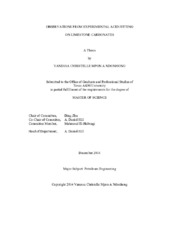| dc.description.abstract | Well stimulation is a common practice in petroleum engineering, applied when the production does not meet expectations. Acid jetting is one of the acid stimulation methods, used in carbonate reservoirs where formation damage is present. In acid jetting, an acid solution is “jetted” unto the wellbore surface in the producing zone with the objective of removing the mud filter cake and bypassing the damaged zone by creating wormholes. As for any other stimulation treatments, experimental core studies are performed to get a better understanding of the process and how it can be controlled to achieve successful treatments.
Previous experimental studies have revealed a trend in the experimental results of high velocity acid jetting, namely the formation of a cavity in the vicinity of the injection nozzle, often followed by wormhole propagation from the cavity, throughout the core. These observations have raised the need for a thorough study. For this study, more experiments are run with the objective of qualitatively identify the key parameters affecting the dissolution pattern observed and compare their relative impact. Experiments are conducted on Indiana limestone and Winterset limestone cores of dimension with 15 wt% hydrochloric acid. Different injection rates were used in the experiments, while holding a constant pressure differential across the core, determined from a desired initial interstitial velocity. Permeability values of the cores range from 0.70 mD to 11.50 mD with porosity values between 12% and 25%.
The experimental results show that the key parameters to acid jetting experiments are interstitial velocity across the core, pressure difference across the core, rock permeability, rock heterogeneity and/or pore structure, and acid injection rate. The interstitial velocity across the core appears to be the governing parameter, at all injection rates used. CT scans of the cores after experiments also suggest the existence of optimum conditions for the pressure difference, corresponding interstitial velocity and flux, at which the acid forms a minimal cavity and a less-branched, straight wormhole to breakthrough. These optimum conditions vary with the acid injection rate. | en |


